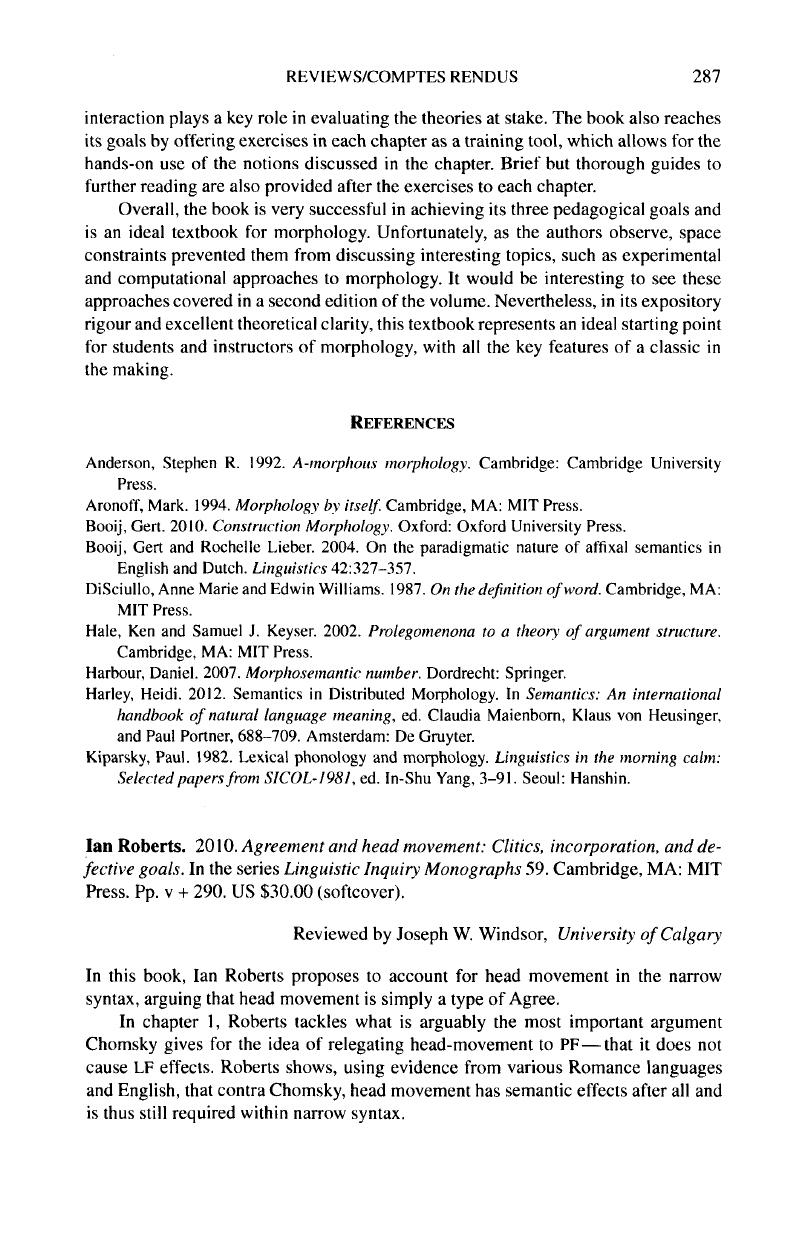No CrossRef data available.
Article contents
Ian Roberts. 2010. Agreement and head movement: Clitics, incorporation, and defective goals . In the series Linguistic Inquiry Monographs 59. Cambridge, MA: MIT Press. Pp. v + 290. US $30.00 (softcover).
Published online by Cambridge University Press: 06 January 2016
Abstract
An abstract is not available for this content so a preview has been provided. Please use the Get access link above for information on how to access this content.

- Type
- Reviews/Comptes Rendus
- Information
- Canadian Journal of Linguistics/Revue canadienne de linguistique , Volume 59 , Issue 2 , July 2014 , pp. 287 - 291
- Copyright
- Copyright © Canadian Linguistic Association. 2015
References
Baker, Mark. 1988. Incorporation: A theory of grammatical function changing.
Chicago: University of Chicago Press.Google Scholar
Bennett, Ryan, Elfner, Emily, and James, McCloskey. In press. Pronouns and prosody in Irish. In Proceedings of the 14th International Congress of Celtic Studies (Plenary Addresses). Dublin Institute for Advanced Studies.Google Scholar
Bošković, Zeljko and Nunes, Jairo. 2007. The copy theory of movement: A view from PF. In The Copy Theory of movement, ed. Corver, Norbert and Nunes, Jairo, 13–74. Amsterdam: John Benjamins.CrossRefGoogle Scholar
Chomsky, Noam. 2001. Derivation by phase. In Ken Hale: A life in language, ed. Kenstowicz, Michael, 1–52. Cambridge, MA: MIT Press.Google Scholar
Chung, Sandra and McCloskey, James. 1987. Government, barriers and small clauses in modern Irish. Linguistic Inquiry
18:173–237.Google Scholar
Cinque, Guglielmo
2005. Deriving Greenberg's universal 20 and its exceptions. Linguistic Inquiry
36:315–332.CrossRefGoogle Scholar
Downing, Laura J.
2013. Issues in the phonology-syntax interface in African languages. In Selected Proceedings of the 43rd Annual Conference on African Linguistics, ed. Orie, Olanike Ola and Sanders, Karen W., 26–38. Somerville, MA: Cascadilla Press.Google Scholar
Elfner, Emily. 2011. The interaction of linearization and prosody: Evidence from pronoun postposing in Irish. In Formal approaches to Celtic linguistics, ed. Carnie, Andrew, 17–40. Newcastle upon Tyne: Cambridge Scholars.Google Scholar
Embick, David and Noyer, Rolf. 2001. Movement operations after syntax. Linguistic Inquiry
32: 555–595.CrossRefGoogle Scholar
Mulkern, Ann E.
2011. Left right behind: Irish pronoun postposing and information structure. In Formal approaches to Celtic lingiustics, ed. Carnie, Andrew, 179–202. Newcastle upon Tyne: Cambridge Scholars.Google Scholar
Rackowski, Andrea and Norvin, Richards. 2005. Phase edge and extraction: A Tagalog case study. Linguistic Inquiry
36:565–599.CrossRefGoogle Scholar
Ritter, Elizabeth. 1991. Two functional categories in noun phrases: Evidence from Modern Hebrew. Syntax and Semantics
25:37–62.Google Scholar
Selkirk, Elisabeth. 2009. On clause and intonational phrase in Japanese: The syntactic grounding of prosodic constituent structure. Gengo Kenkyu
136:35–73.Google Scholar
Selkirk, Elisabeth. 2011. The syntax-phonology interface. In The liandbook of phonological theory (2nd ed.), ed. Goldsmith, John, Riggle, Jason, and Yu, Alan, 435–484. Oxford: Blackwell.Google Scholar
Zubizarreta, Maria Luisa. 1998. Prosody, focus, and word order.
Cambridge, MA: MIT Press.Google Scholar




